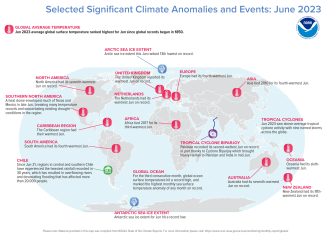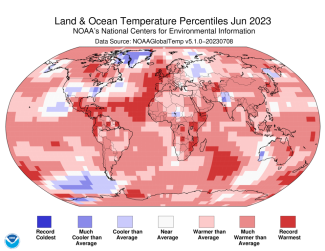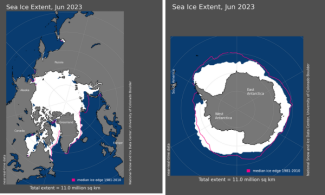Earth had its warmest June on record; June sea surface temperature anomaly was highest for any month on record

June Highlights:
- For the third consecutive month, global ocean surface temperatures set a record high.
- Smoke plumes from Canada’s most destructive wildfire season reached European skies.
- Antarctica saw its second consecutive month of record-low sea ice extent.
- With nine tropical storms across the globe, June 2023 had a global accumulated cyclone energy that was almost twice its average value for the month.
Globally, June 2023 set a record for the warmest June in the 174-year NOAA record. The year-to-date (January–June) global surface temperature ranked as the third warmest such period on record. According to NCEI’s Global Annual Temperature Outlook, it is virtually certain (> 99.0%) that the year 2023 will rank among the 10-warmest years on record and a 97% chance it will rank among the top five.
This monthly summary, developed by scientists at NOAA’s National Centers for Environmental Information, is part of the suite of climate services NOAA provides to government, business, academia and the public to support informed decision-making.
Monthly Global Temperature
The June global surface temperature was 1.89°F (1.05°C) above the 20th-century average of 59.9°F (15.5°C), making it the warmest June on record. This marked the first time a June temperature exceeded 1.8°F (1°C) above the long-term average. June 2023 was 0.23°F (0.13°C) warmer than the previous June record from 2020, but 0.52°F (0.29°C) cooler than the all-time highest monthly temperature anomaly on record (March 2016). June 2023 marked the 47th consecutive June and the 532nd consecutive month with temperatures at least nominally above the 20th-century average.
For the third consecutive month, global ocean surface temperature hit a record high. Weak El Niño conditions that emerged in May continued to strengthen in June, as above-average sea surface temperatures returned to the equatorial Pacific Ocean. Globally, June 2023 set a record for the highest monthly sea surface temperature anomaly of any month in NOAA’s 174-year record. June heat was not limited to the ocean surface; the Southern Hemisphere had its warmest June on record and the Northern Hemisphere tied 2019 for its warmest June.
The Caribbean Islands experienced their warmest June on record. Africa tied 2017 for its third-warmest June on record, and South America, Europe, and Asia (tied with 2010) each had their fourth-warmest June on record. Oceania had its sixth-warmest June, and June in North America ranked seventh warmest on record. Wildfires that began in May continued to scorch Canadian forests in June, burning over 20 million acres since the beginning of 2023 to become Canada’s most destructive wildfire season on record. Millions of Canadians and Americans experienced widespread and sustained air quality issues throughout much of June, with smoke plumes reaching as far as Europe.
Temperatures were above average throughout most of South America, Europe, Africa and Asia. Parts of northern and southern North America, Oceania, Antarctica and the Arctic also experienced warmer-than-average temperatures this month. Sea surface temperatures were above average across much of the northern, central and western Pacific, the Atlantic and the Indian Ocean. Parts of the eastern Atlantic, the southwestern Pacific, the southern Indian Ocean, as well as parts of northern Canada, Mexico, western Europe and southern Africa saw record-warm June temperatures. Combined, record-warm temperatures covered just over 8.6% of the world’s surface this month, which marks the highest June percentage since 1951.
Temperatures were near to cooler than average across parts of the U.S., Greenland, western Russia, Pakistan and northern India, western Australia, Chad and northeastern Nigeria. Sea surface temperatures were near to below average over parts of the central-eastern and southeastern Pacific and the northwestern Atlantic Ocean. Less than 1% of the world's surface had a record-cold June.
Sea Ice Extent
June 2023 set a record for the lowest global June sea ice extent on record. This primarily resulted from record-low sea ice extent in the Antarctic, which saw its second consecutive month with the lowest sea ice extent on record. Globally, sea ice extent in June 2023 was 330,000 square miles less than the previous record low from June 2019.
The Arctic sea ice extent for June 2023 ranked as the 13th smallest in the satellite record at 4.23 million square miles, or about 130,000 square miles below the 1991–2020 average. The Antarctic sea ice extent ranked lowest on record at 4.25 million square miles, or 940,000 square miles below the 1991–2020 average. This was 470,000 square miles below the previous record low from June 2022.
Global Precipitation
Below-average June precipitation was observed across parts of western and southern North America, southern South America, northern Europe, northern China and the eastern and western coasts of Australia. Wetter-than-average conditions were present across parts of the eastern U.S., southwestern Europe, Turkey, equatorial western Africa, Pakistan and southeastern Australia.
Global Tropical Cyclones
Nine named storms occurred across the globe in June, four of which reached tropical cyclone strength (≥ 74 mph). One storm reached major tropical cyclone strength (≥ 111 mph). These counts are all above 1991–2020 averages for June. The global accumulated cyclone energy, an integrated metric of the strength, frequency, and duration of tropical storms, was almost twice its average value in June. The Atlantic basin saw three tropical storms this June, which ties eight other years for the most in June.
For a more complete summary of climate conditions and events, see our June 2023 Global Climate Report or explore our Climate at a Glance Global Time Series.







